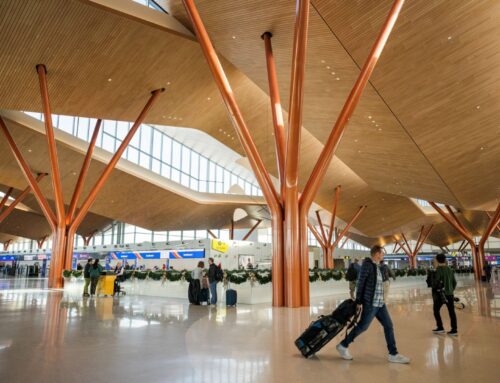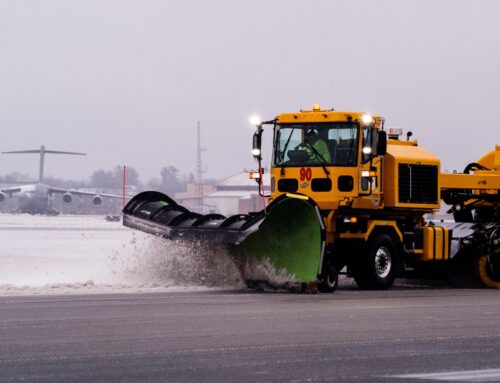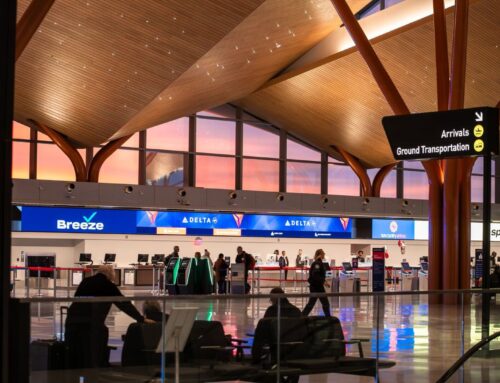Public Art Adds Creativity to Billion-Dollar Terminal Project
Two artists commissioned to develop large-scale works
By Matt Neistein
Published January 14, 2022
Read Time: 5 mins
Pittsburgh’s new billion-dollar airport terminal is a huge construction project, and it requires similarly expansive imaginations to weave artwork into its very DNA.
Enter Adam Kuby and Patrick Marold.
Kuby and Marold are the first two nationally renowned artists commissioned to create large-scale artwork for Pittsburgh International’s Terminal Modernization Program, a crucial component of the project right alongside foundational beams and poured concrete.
“From the beginning, we knew we needed dynamic artists to collaboratively create with our design team in support of the ‘nature, technology and community’ design vision,” said Rick Lee, TMP Implementation Manager. “Patrick and Adam’s immense talent and artistic sensibilities exemplify that vision, and I am extremely excited about the development of the remaining artwork to come.”
Kuby, who is based in Portland, Ore., first began detailing his ideas for the new terminal’s retaining walls for roads and bridges, as well as the facade for the multi-modal complex, in 2019.
The result, “Cross Currents,” is composed of patterns grooved right into the concrete used to build those structures, giving texture and visual touchpoints to what would otherwise be broad swaths of plain stone.
“I was trying to bring a sense of the region’s geography and geology and topography and hopefully sort of ground the roads and bridges into the landscape,” Kuby said. “Tie them a little more closely to the land that they’re actually occupying.”
Kuby’s art will be created using pre-cast concrete panels with 21 unique patterns scored into the surface. Both settings, the walls and the garage façade, will use the same grids, lines and pulses, although the wall patterns will be denser.
“The aesthetic that I tried to work with on the roads and bridges, the vocabulary I’m trying to use, has a kind of high-tech, digital flow of energy feel to it,” Kuby said, adding that he thinks the two settings will “speak” to each other when seen together.
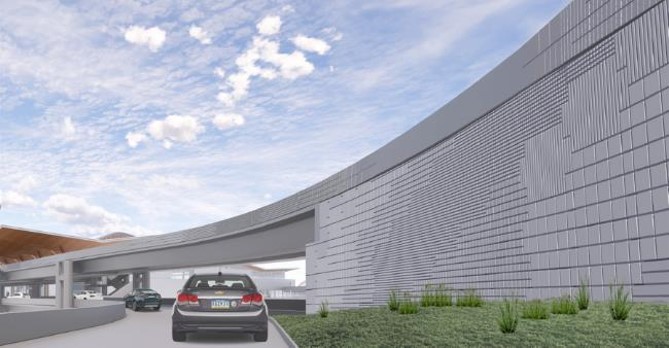
“Cross Currents” is composed of patterns grooved right into the concrete used to build the multi-modal complex and new roads and bridges. (Image courtesy of Adam Kuby)
A perspective that allows one to see both elements will then also include Marold’s “Open Columns” artwork, which will highlight the pedestrian walkways surrounding the multi-modal complex.
The series of four 20- to 40-foot-tall steel cylinders immediately evokes the smokestacks of Pittsburgh’s steelmaking heritage—a very intentional choice, Marold said.
“There’s this very rich history that newer industries are building on to redefine Pittsburgh. It’s a great city that way,” he said. “It’s not being wiped clean, it’s being built from within, and that’s really exciting and beautiful to see.”
Marold, who works out of Boulder, Colo., has designed the hollow columns so that they are large enough to enter. Once inside, a polished metal interior will catch the sunlight, presenting a stark contrast to the oxidized exterior.
“I hope there’s that surprise when [people] enter these columns and they see the reflective interior,” he said. “The way I’ve described it is the sky starts to dissolve into your peripheral vision.”
Several more artists—some national, some local—have been commissioned to develop concepts, creating original work for various areas inside the new terminal.
It was important for the Allegheny County Airport Authority to find the right mix of creative minds to achieve the TMP’s artistic goals, said Renee Piechocki, TMP art and design consultant and longtime member of PIT’s Art in the Airport committee.
Artists applied to open calls and were reviewed by selection panels that included ACAA staff, regional arts professionals and design team members.
The art commissioned for the TMP is an extension of the airport’s robust arts and culture program, which has hosted artists-in-residence, participated in industrywide virtual concerts and prioritized giving local creatives a platform for their work.
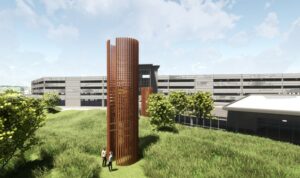
A series of 20- to 40-foot-tall cylinders will be designed to emulate smokestacks that represent Pittsburgh’s steelmaking heritage. (Image courtesy of Patrick Marold)
“Art is an immediate way for people traveling through the airport to connect with their environment and our creative community,” said Keny Marshall, Arts and Culture Manager at the airport.
“So many great conversations about our airport, the art collection and how we fit into the creative community start right here. Our program creates a place where everyone can collectively appreciate and interact with our region and the world around them.”
Both Kuby and Marold have extensive experience with large-scale public art, which is part of what brought them to the Pittsburgh project. Marold has done work for airports in Denver, Dallas and Fort Lauderdale, while this is Kuby’s first time creating in an airport setting.
“It’s exciting to see the sheer number of people that will pass through the airport environment,” Kuby said. “It’s so much more than some of the other sites I’ve had in public parks and streetscapes, so that is another level up.”
A native of Philadelphia, Kuby has previous ties to Pittsburgh. His sister attended Carnegie Mellon University and he has worked in the past with CMU grad Shohei Katayama, whose “Flight” sculpture (created with Michael Neumann) hangs on the airport’s Arrivals curbs.
Marold, on the other hand, took some time to visit Western Pennsylvania to learn more about the region and find inspiration for his artwork, including spending time as an artist-in-residence at Fallingwater.
“Pittsburgh is at a really fresh and exciting stage for me. It’s been so long since that airport has had major renovations or new infrastructure,” he said. “It’s just an exciting project to be a part of because it’s going to redefine so much for people.”
The arts program at PIT has explored new ways to connect guests and staff with creatives, from its artist-in-residence programs to interactive workshops and more. But the opportunity to imagine and build art right into the architecture of a state-of-the-art terminal doesn’t come along very often.
“It injects a cultural identity, a cultural experience, where often we’re overwhelmed by signage or the function of getting from one place to another. It presents a sense of humanity into some of these environments that may be sterile,” Marold said.

